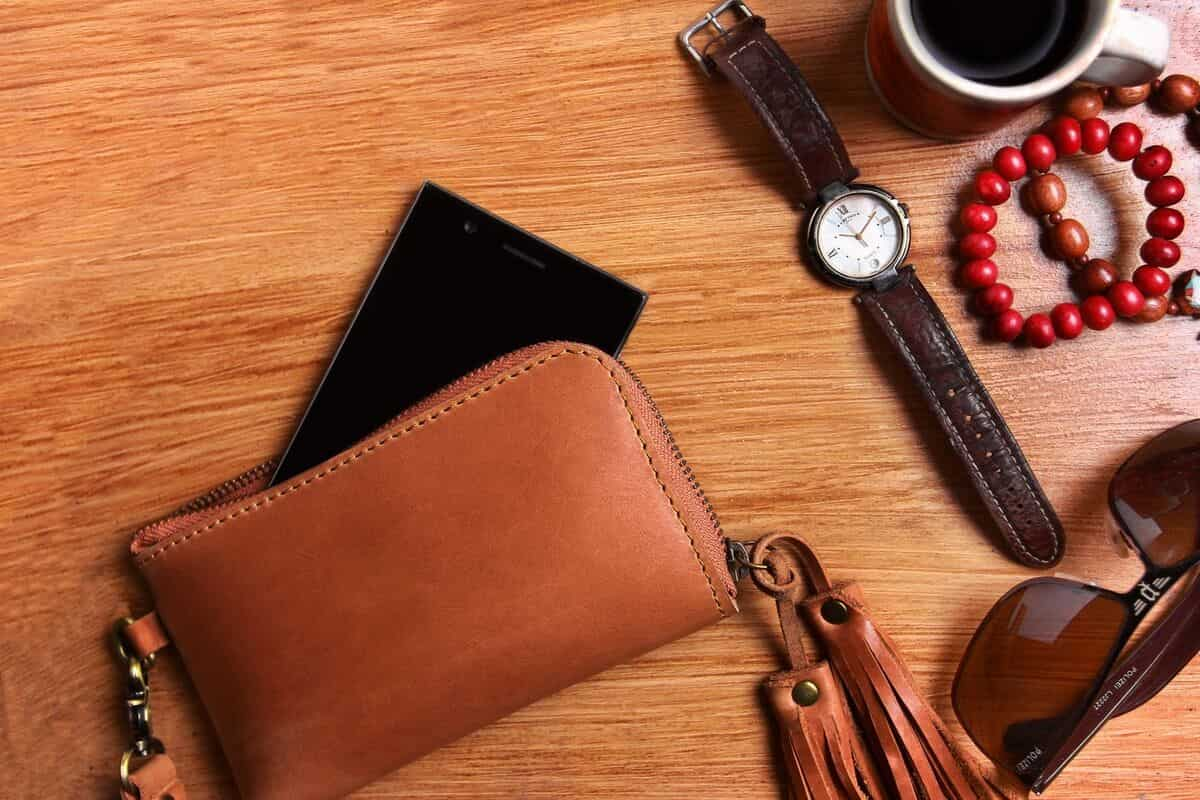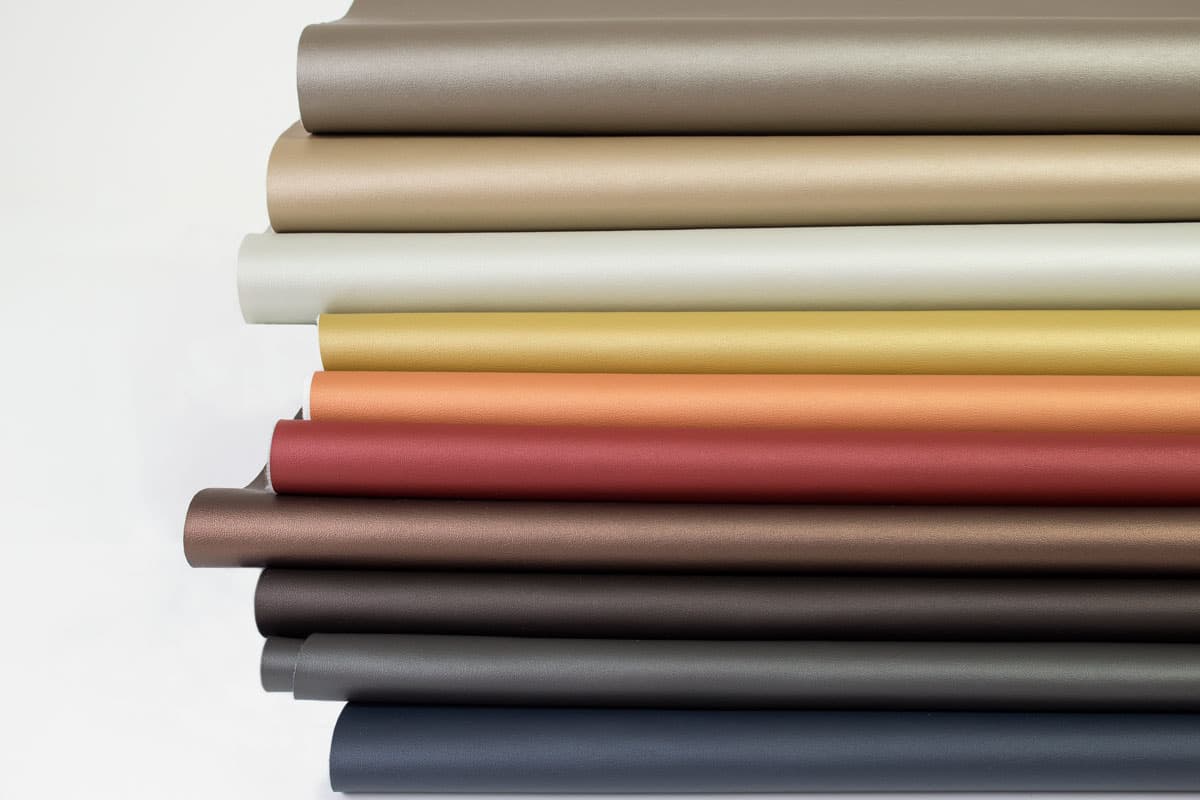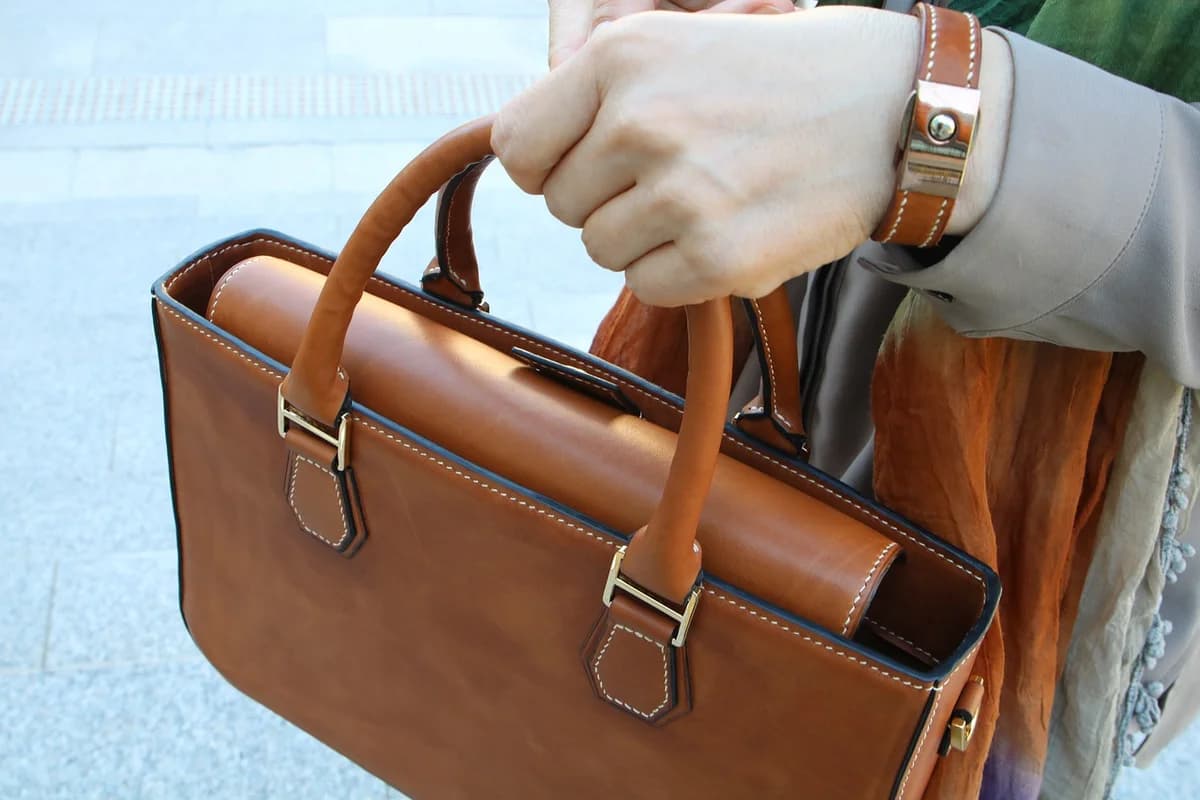All synthetic leather is vegan leather since faux leather is, by definition, created without the use of any animal products. Both of them are durable and used interchangeably. Artificial imitation leather is known as faux leather. It's a synthetic fabric that has been specially created to mimic the appearance and texture of real leather without utilizing any animal by-products. In reality, faux leather can be used to upholster nearly any piece of furniture just like real leather. It is used to make a variety of common things like shoes, bags, apparel, and even vegan sofas. Faux leather goes by many other names, such as artificial, synthetic, or vegan leather. On occasion, you may also hear the terms pleather and leatherette.
 Leather
Leather
However, they all essentially refer to the same thing: a synthetic substitute for leather that is produced without using any products from animals. Faux and real leather can appear strikingly similar to the untrained eye. But if you look very closely, you'll notice that the texture and markings on the fabric change just slightly from one another. While faux leather appears more even and constant since the grain is an artificial replica, real leather keeps the uneven grain and minor surface defects that come with natural animal skin. The texture of faux leather is created by treating a layer of synthetic plastic coating that is put onto a cloth background. Wax, dye, polyamide microfibre, polyvinyl chloride (often referred to as PVC), and polyurethane are the most popular chemical components used to create this plastic covering (sometimes called PU leather). Making faux leather involves the following steps: Step1: a synthetic base layer, commonly comprised of polyester, is coated with a plastic-based synthetic material. Step 2: The synthetic coating is covered with dye to produce the desired color. Step 3: To give the material the pore marks and grain of genuine leather, a textured finish is added. This step frequently involves chemical treatments and embossing machines. Due to this, it has the surface feel and appearance of real leather. Unlike genuine hides, from which the best pieces must be chosen and trimmed, faux leather is manufactured using a machine and may thus be cut by the meter like every synthetic fabric.
 Genuine leather wallet for men
Genuine leather wallet for men
vegan leather pros and cons
Typically, vegan leather has some fixed pros and also some cons. Therefore, the list of pros and cons is derived from them. The pros -The production of vegan leather does not include any form of animal cruelty, as no animals are harmed in the process. -There has not been any tanning process that is harmful to the environment. -The synthetic material known as "pleather" or "vegan leather" is available at surprisingly low prices. -There are some features and colors that leather can't supply, but vegan leather is capable of providing them. The cons -The material known as "vegan leather" or "synthetic leather" is simply plastic; it is a microfibre that is produced from petroleum, which is another name for oil. Petroleum is a resource that does not replenish itself. -The use of chemicals is necessary for the transformation of oil into vegan leather. -Concerns may also arise for the workers involved in the production of vegan leather, but this factor is very dependent on the country or countries in which the goods are manufactured. -PVC and other types of synthetic leather do not allow air to pass through them, which can result in feet that get smelly and clammy. -The quality might be inconsistent, which results in vegan leather that is less long-lasting. -Both PVC and PU are not capable of decomposing in the environment. It shatters into ever-tinier (plastic) bits and pieces. - The flexibility of leather is not reproduced in vegan leather.
 Faux leather benefits durability
Faux leather benefits durability
is synthetic leather good
The use of synthetic leather is what makes it such a good option for you to choose. When selecting materials for a leather project, natural leather may not always be the best option. In certain circumstances, synthetic leather, also known as faux leather, may actually perform better. Plastic is most commonly used in the production of synthetic leather, which is a material that is designed to mimic the appearance of natural leather. It comes in a huge range of different textures, colors, and finishes, and it can even smell different in some cases. The most typical applications for synthetic leather are in apparel, shoes, luggage, and cases, as well as upholstery. In that case, how does the use of synthetic leather differ from the use of natural leather? When would you consider making use of it as a valuable material? Let's explore.
The substance known as synthetic leather is designed to mimic the look and feel of genuine leather. The production of genuine leather is quite pricey, and the material itself comes from the skin of animals. Plastics and polymers are the primary sources from which synthetic leathers are constructed. Because of this, they can be produced much more quickly and easily, and they also require far less maintenance than raw leather does. The term "synthetic leather" refers to a sort of fabric that is made of plastic. Because it is a material that is created by humans, synthetic leather may be crafted to fulfill a wide range of requirements across many different sorts of industries. Additionally, the components can be manufactured in very large volumes, even rolls in some cases. This is in contrast to the majority of natural leathers, which have restrictions due to the size of the hide. Producing synthetic leathers can take place either on a backing made of fiber-based fabric or one made of flexible plastic (such as polyester). There are some, albeit very few, similarities between real leather and synthetic leather. In general, it will only last a few years and will start to become brittle and break when it is used in products that are subjected to a significant amount of bending and flexing on a regular basis (an example such as shoes). However, on account of the numerous advantages it offers, it has become an exceptionally well-liked material option and a fundamental component of the modern market. 
is protein leather vegan
If you are working in the leather industry or even a fan of leather, this question pops into your mind whether protein leather is vegan or not? In order to replace the many varieties of leather, protein leather is an artificial leather made of a material. The slang word "Pleather," which also applies to plastic leather, is used to describe protein leather. Protein leather, as the term was originally used, was an artificial leather made by mixing protein powder with resin to create a strong, malleable sheet of material that feels and looks substantially like leather. Manufacturers now refer to polyurethane products manufactured by attaching the plastic to a fabric backing, typically cotton or polyester, as "pleather," which is a term they've been using for a while. As an affordable alternative to leather, it is frequently utilized. The "top-grain" or grain of the leather is frequently imprinted on pleather. Concerning the general design, protein leather is typically used for earpads. Here's the genuine deal, shall we say. The vegan or fake category includes this kind of leather. Due to its durability, this serves as a suitable substitute for genuine leather.  In order to create flexible sheets, protein leather combines resin and protein powder. In terms of durability and appearance, these sheets resemble leather. Protein leather, which is often referred to as Pleather, is a relatively recent word used by manufacturers to describe a polyurethane product made by fusing plastic to a basis of cloth. In order to give it a leather-like appearance and feel, embossing was also added to the top. Also available in low, medium, and high quality is protein real leather. Car seats, headphones, and other equipment that is subjected to heavy wear and tear employ the best materials available. In the same way, as full-grain leather does, the best quality provides the most durability. The fabric backing, which is discrete enough to endure wear and tear, is what gives this item its level of durability. There are benefits and drawbacks to synthetic leather. Protein leather has a number of benefits, including the fact that it is vegan, meaning no animals were harmed in the process of making the leather, as well as the fact that it is significantly less expensive than real or even genuine leather. The gluing of the fabric backing and plastic topcoat on the leather gives it extremely high resilience, which is crucial for enduring severe wear and tear.
In order to create flexible sheets, protein leather combines resin and protein powder. In terms of durability and appearance, these sheets resemble leather. Protein leather, which is often referred to as Pleather, is a relatively recent word used by manufacturers to describe a polyurethane product made by fusing plastic to a basis of cloth. In order to give it a leather-like appearance and feel, embossing was also added to the top. Also available in low, medium, and high quality is protein real leather. Car seats, headphones, and other equipment that is subjected to heavy wear and tear employ the best materials available. In the same way, as full-grain leather does, the best quality provides the most durability. The fabric backing, which is discrete enough to endure wear and tear, is what gives this item its level of durability. There are benefits and drawbacks to synthetic leather. Protein leather has a number of benefits, including the fact that it is vegan, meaning no animals were harmed in the process of making the leather, as well as the fact that it is significantly less expensive than real or even genuine leather. The gluing of the fabric backing and plastic topcoat on the leather gives it extremely high resilience, which is crucial for enduring severe wear and tear. 
how to make vegan leather
Among all types of leather, vegan leather has a simple process to make. The term vegan leather refers to any material that resembles leather but is not really made from animal skins or through any processes that involve the exploitation or abuse of animals in any way. There are numerous other names for leather that are not derived from animals. Some of these names include faux leather, synthetic leather, leatherette, PU leather, and pleather (which is a horrible portmanteau word that is a blend of the words "plastic" and "leather"). Although there is a wide variety of vegan leather, it can be simplified by dividing it into just two categories. Natural vegan leather is sometimes referred to as "plant leather" natural vegan leather is sometimes referred to as "plant leathers" natural vegan leather is made from plant-based materials such as cork, pineapple, and walnut natural vegan leather is made from plant-based materials or, they are products produced from fungus, such as mushroom leather, or even from algae (really!).  Synthetic Vegan Leather Synthetic vegan leather refers to materials such as PU leather, which is created from polyurethane, or other possibilities that are based on plastic. In spite of the fact that these materials are sometimes grouped together and referred to as "pleather," the vast majority of the time they are produced straight from petrochemicals. On occasion, though, recovered plastics are used instead. Because it is technically considered to be a hybrid of natural and synthetic materials, "lab-grown vegan leather" may be considered to fall into a third category all on its own. This possibility is up to debate. However, in order for such materials to be "developed," they generally utilize biological natural organisms as a substrate, such as fungi or algae, thus we will describe such materials as natural. There are pros and cons associated with each type of vegan leather, but the fact that none of them are produced using the skins of animals is the most significant benefit for vegans. Aside from that, there are significant environmental benefits associated with the majority of vegan leather products in comparison to those made from animal leather.
Synthetic Vegan Leather Synthetic vegan leather refers to materials such as PU leather, which is created from polyurethane, or other possibilities that are based on plastic. In spite of the fact that these materials are sometimes grouped together and referred to as "pleather," the vast majority of the time they are produced straight from petrochemicals. On occasion, though, recovered plastics are used instead. Because it is technically considered to be a hybrid of natural and synthetic materials, "lab-grown vegan leather" may be considered to fall into a third category all on its own. This possibility is up to debate. However, in order for such materials to be "developed," they generally utilize biological natural organisms as a substrate, such as fungi or algae, thus we will describe such materials as natural. There are pros and cons associated with each type of vegan leather, but the fact that none of them are produced using the skins of animals is the most significant benefit for vegans. Aside from that, there are significant environmental benefits associated with the majority of vegan leather products in comparison to those made from animal leather. 
is faux leather durable
Faux leather is durable. faux leather has excellent longevity due to its high level of durability. It is not easily damaged by abrasions such as scratches or scrapes, which would ruin genuine leather. In contrast to leather, it is not prone to flaking or cracking. It is resistant to stains and ultraviolet (UV) light will not cause it to fade as quickly as other types of light. In most cases, a damp rag and some warm water are all that are required to clean faux leather products. Because it does not absorb moisture in the same way that genuine leather does, goods made of faux leather will not grow deformed or cracked over time. Only a dry cloth needs to be used on some of the modern performance faux leathers to remove stains such as ink, liquid, and food. The appearance of faux leather has been adjusted and improved with a variety of changes in grain, color, and textures in order to represent a visual appearance with the quality of authentic leather.  Because all of the components are cut from the same sheet of faux leather, you can expect a unified appearance. When compared to real leather, faux leather is much simpler to cut and sew. Additionally, needle marks are typically less obvious, and threads are able to mix in with the texture of faux leather in a more seamless manner. When compared to genuine leather, faux leather does come with a few significant drawbacks. It does not stretch, breathe, or wear as real leather does. Faux leather. However, unlike real leather, faux leather does not get shinier or acquire a patina with age in the same way that real leather does. However, unlike genuine leather, faux leather is not resistant to being torn or punctured.
Because all of the components are cut from the same sheet of faux leather, you can expect a unified appearance. When compared to real leather, faux leather is much simpler to cut and sew. Additionally, needle marks are typically less obvious, and threads are able to mix in with the texture of faux leather in a more seamless manner. When compared to genuine leather, faux leather does come with a few significant drawbacks. It does not stretch, breathe, or wear as real leather does. Faux leather. However, unlike real leather, faux leather does not get shinier or acquire a patina with age in the same way that real leather does. However, unlike genuine leather, faux leather is not resistant to being torn or punctured.


0
0